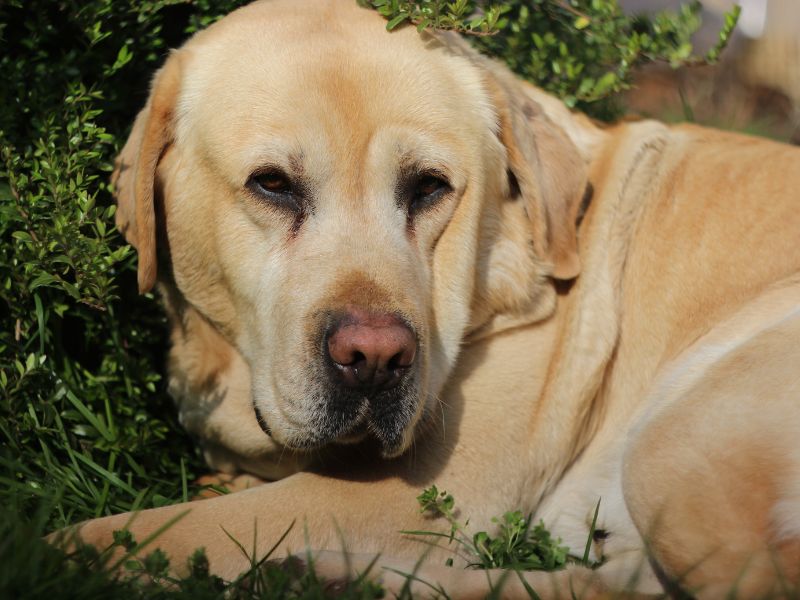Dudley Labradors are a unique type of Yellow Labrador, known for their pinkish-colored noses, eye rims, and feet. This distinct appearance is a result of their lack of pigmentation, which is inherited through their genetics. Often called “pink-nosed Labradors,” Dudley Labs are a charming and unusual variation of one of the most popular dog breeds in the world.
These special Labradors have their origins rooted in the three recognized Labrador colors: black, chocolate, and yellow. Although they share many qualities with other Labradors, such as their friendly temperament and athletic abilities, Dudley Labs truly stand out because of their distinctive pink features.
In addition to their coloring, Dudley Labradors often have pale-colored eyes, commonly seen in shades of blue or teal. This remarkable appearance has attracted the curiosity and affection of dog lovers worldwide, making Dudley Labs a fascinating subject for further exploration.
What Is A Dudley Lab?
A Dudley Lab is a unique type of Yellow Labrador Retriever, characterized by its lack of pigmentation in specific areas, such as the nose, eye rims, and feet. These areas appear pink, giving the dog a distinctive appearance. Dudley Labs also tend to have pale-colored eyes, usually blue or teal. This intriguing genetic trait occurs only in Yellow Labradors and is passed down through generations.
While Dudley Labs may have an unusual appearance, they are still Labrador Retrievers at heart. They possess the same loving, intelligent, and energetic nature that makes Labradors one of the most popular dog breeds worldwide. These dogs excel in various activities, including fetching, swimming, and serving as excellent family pets.
Despite their fascinating looks and similar personalities to other Labs, Dudley Labradors are relatively rare. Their coat color may present as a light silver or almost tan shade, sometimes accompanied by patches of white. Here are a few more quick facts about Dudley Labs:
- The lack of pigmentation is a genetic trait
- This trait is exclusive to Yellow Labs
- They often have pale-colored eyes, such as blue or teal
- Dudley Labradors are relatively rare compared to other Labrador colors
In summary, a Dudley Lab is a unique and rare variation of the Yellow Labrador Retriever, distinguished by its pink nose, eye rims, and feet. While their appearance is different, they share the same endearing qualities common to all Labradors, making them loving and loyal companions.
Labrador Pigmentation Genetics
Labrador Retrievers come in three main colors: black, chocolate, and yellow. These colors result from the interplay of two primary genes, the Extension (E) gene and the Agouti (A) gene.
The Extension gene controls the production of melanin, which gives color to the fur. The dominant E allele allows the production of both black and yellow pigmentation, while the recessive e allele only allows yellow pigmentation. A Lab with two e alleles (ee) will always have a yellow coat. The Agouti gene further influences coat color with the dominant A allele causing the black pigment, while the recessive a allele leads to chocolate pigmentation.
Dudley Labradors are a rare genetic variation among Labradors with a unique trait of having a pink nose, eye rims, and feet. This is due to a lack of pigmentation in these areas, which is generally black or brown. The distinct pink coloration of a Dudley Lab is a result of the combination between the yellow coat color genes (ee) and an additional gene that affects pigmentation – specifically, the gene responsible for the pink appearance on the nose, eye rims, and feet.
It is important to note that Dudley Labs are not genetically defective. They are simply a rare color variation of the breed, and their genetics don’t impact their overall health or lifespan. The personality of Dudley Labs is also consistent with other Labrador Retrievers, making them lovable and friendly pets.
In conclusion, the genetics behind Labrador pigmentation are fascinating and complex. The interplay of several genes determines the coat color and unique pigmentation variations, such as the pink-nosed Dudley Labrador. These Labs maintain the same friendly temperament and qualities as their non-Dudley counterparts, making them an interesting and delightful addition to the Labrador family.
Get Pippa’s Training Tips!
Pippa offers an excellent resource for those looking to train their Dudley Labrador puppies. Her dog training tips cover a wide range of useful topics, from specifics like heel work and recall, to more general tips on getting your dog’s attention, avoiding mistakes, and setting both you and your dog up for success. The tips provided are friendly, easy to understand, and perfect for all pet owners, regardless of experience level.
One of the best parts about Pippa’s training tips is that they’re completely free! To access these helpful insights, all you need to do is sign up using your email address. Once you’ve joined the list, you will receive valuable information and advice directly to your inbox.
Sometimes, emails from a new address might land in your spam or junk folder, so it’s important to check there if you don’t hear from Pippa right away. If you still can’t find the emails, feel free to reach out to Pippa’s Dogsnet Training Team, and they will gladly assist you in getting connected.
These training tips are not only engaging and informative but are also tailored to the specific needs of Dudley Labradors. By following Pippa’s guidance, you can ensure a well-trained, happy, and healthy dog, making your experience as a Dudley Lab owner truly special.
Remember, training your unique breed of Dudley Labrador is essential for the dog’s overall well-being and success as a member of your family. With Pippa’s training tips, you’ll have the tools you need to help your precious pup flourish in their new home. So, don’t hesitate – sign up today and start your journey with Dudley Lab training made simpler and enjoyable!
Black Labrador Nose Turning Pink
A common question among Labrador owners is why their dog’s black nose might turn pink. This change in color can occur for a variety of reasons, and this section will explore some of these causes.
Dudley Labradors are a specific type of Labrador with a pink nose throughout their life. This is due to a unique genetic combination that causes a lack of pigmentation around their nose, gums, eye rims, and feet. While Dudley Labs are quite rare, it’s important to note that not all Labradors with pink noses are considered Dudleys.
The process of a Labrador’s nose turning pink when they become older is called depigmentation. This is quite common among many Labradors and not usually a cause for concern. Depigmentation is not limited to Dudley Labs, and it can be observed in other variants as well.
Weather can also be a factor in a Labrador’s nose changing color. A yellow Lab’s nose might appear darker most of the year but turn pink during certain seasons, such as winter. This seasonal change in nose color is not unique to Dudley Labs and can be seen in other Labrador breeds.
Injuries, such as cuts and abrasions, can also cause a Labrador’s nose to turn pink while it is healing. Allergies and specific health conditions may lead to changes in nose pigmentation as well. It’s essential to monitor any such changes and consult with a veterinarian if you notice persistent or severe discoloration in your Labrador’s nose.
So, while Dudley Labradors are known for their unique pink noses, it’s important to be aware that a variety of factors can cause other Labrador breeds to experience a change in nose color. With proper care and attention, every dog can enjoy a happy and healthy life, regardless of their nose color.
Pink Nose Problems In Labradors
Labradors with pink noses, also known as Dudley Labradors, have a unique genetic trait that results in a lack of pigmentation around their nose, eyes, and feet. While this may give them a distinctive appearance, it can also lead to some health issues.
One of the main problems with pink noses in Labradors is that the lack of pigmentation makes them more susceptible to sunburn. This can cause the skin on their nose to become red, inflamed, and painful. Over time, repeated sun exposure can also increase the risk of skin cancer.
To prevent sunburn, it is important to keep Dudley Labradors out of direct sunlight during the hottest parts of the day. Owners should also apply a pet-safe sunscreen to their dog’s nose, ears, and other exposed areas whenever they are outside.
Another issue that can arise with pink noses in Labradors is hyperkeratosis. This is a condition where the skin on the nose becomes thickened and rough, making it difficult for the dog to breathe and causing discomfort. It can also make it harder for the dog to smell, which can affect their quality of life.
To prevent hyperkeratosis, owners should keep their dog’s nose moisturized with a pet-safe balm or lotion. They should also avoid exposing their dog to extreme temperatures, as this can exacerbate the condition.
Overall, while pink noses in Labradors may be unique and eye-catching, they can also lead to some health problems. With proper care and attention, however, owners can help their Dudley Labradors live happy and healthy lives.
Can You Predict Nasal Pigmentation When Breeding?
Breeding dudley Labradors can be a fascinating and rewarding experience. However, predicting the nasal pigmentation of the puppies can be a bit tricky. Here are some factors to consider when breeding Dudley Labs:
Genetics
The lack of pigmentation in the nose, eye rims, and feet of Dudley Labs is a result of a recessive gene. This means that both parents must carry the gene for it to be expressed in their offspring. Therefore, if two Dudley Labs are bred together, all of their puppies will be Dudley Labs. However, if a Dudley Lab is bred with a Labrador with normal pigmentation, only half of the puppies will be Dudley Labs, and the other half will have normal pigmentation.
Coat Color
The color of the Labrador’s coat can also affect the pigmentation of their nose. For example, yellow Labradors are more likely to have Dudley pigmentation compared to black or chocolate Labradors. Therefore, breeding two yellow Labradors together increases the likelihood of producing Dudley Labs.
Environmental Factors
While genetics plays a significant role in the pigmentation of a Labrador’s nose, environmental factors can also influence it. Exposure to sunlight and cold temperatures can cause the nose to become darker or lighter, respectively. Therefore, it is essential to consider the environment when predicting the pigmentation of a puppy’s nose.
In conclusion, predicting the nasal pigmentation of Dudley Labs when breeding can be challenging due to the recessive nature of the gene. However, considering the genetics, coat color, and environmental factors can increase the likelihood of producing Dudley Labs.
Should I Buy A Dudley Labrador Puppy?
Dudley Labradors are just as friendly and active as their dark-nosed counterparts. However, if you are considering buying a Dudley Lab puppy, there are a few things to keep in mind.
Firstly, it is important to note that Dudley Labs are excluded from competition and breeding due to their lack of pigmentation on their nose, muzzle, paw pads, and eye rims. This means that if you are looking for a dog to participate in competitions or to breed, a Dudley Lab may not be the best option for you.
Secondly, Dudley Labradors can be difficult to find. While they can be purchased from the same places as other types of Labradors, they are not as common. This means that you may need to do some extra research and be patient in your search for a Dudley Lab puppy.
Finally, it is important to consider the potential health issues that may arise in Dudley Labs. While they are generally healthy dogs, their lack of pigmentation can make them more susceptible to sunburn and skin cancer. This means that you will need to take extra precautions to protect your Dudley Lab when spending time outdoors.
Overall, if you are looking for a friendly and active companion and are willing to take extra precautions to protect their skin, a Dudley Labrador may be a great choice for you. However, if you are looking for a dog to participate in competitions or to breed, you may want to consider a different breed.














